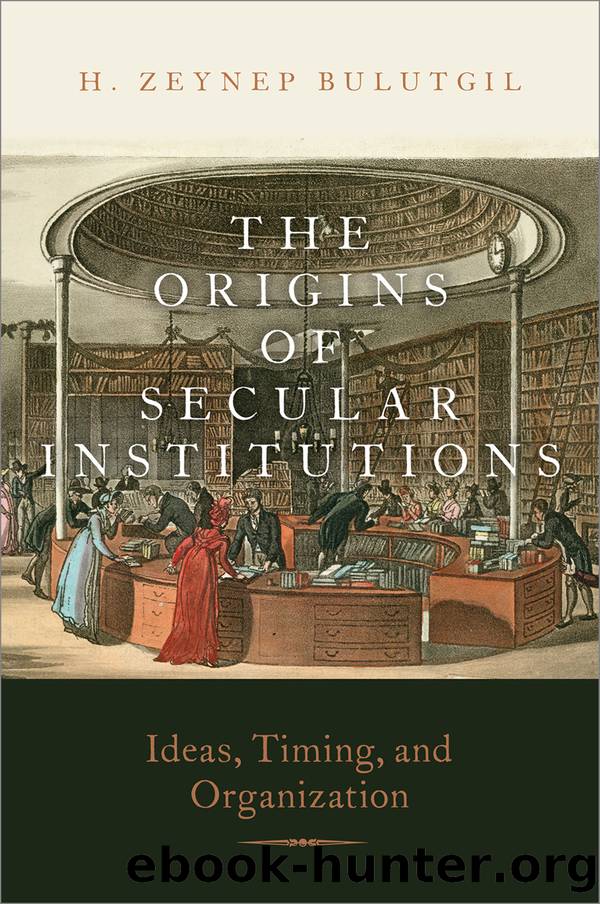The Origins of Secular Institutions by H. Zeynep Bulutgil

Author:H. Zeynep Bulutgil
Language: eng
Format: epub, pdf
Publisher: Oxford University Press
Published: 2021-03-15T00:00:00+00:00
Political Organization, Resilience, and Spread of Secular Reformism
In the forty years that followed, Abdülhamit II remained the unquestioned ruler of the empire. His regime combined three notable features. First, the 1877 war had left the empire with a proportionally much larger Muslim population both due to loss of territory in the Balkans and due to the reception of significant numbers of Muslim refugees from these areas and from Russia. This practical consideration, coupled with the sultanâs personal religiosity, resulted in the emergence of a prevalent state ideology that underscored Islam and his role as the sultan-khaliph (Fortna 2008). Second, Abdülhamit II also established a palace bureaucracy to rival the state administration that had developed during Tanzimat and set up an extensive spy network to keep potential opponents under surveillance. Finally, despite his Islamist ideology and autocratic tendency, Abdülhamit II closely followed and even expanded the earlier educational policies that were put in place during Mahmut II and Tanzimat. He continued to invest in and endorse higher education institutions that were outside the control of the ulema such as the Military Medical Academy, the Military Academy, and the War College and opened a new school for the sons of tribal leaders (Fortna 2008). In this important respect, Abdülhamit II was no different from his predecessors or for that matter from his contemporaries in other empires. Beyond guarding his position of dominance domestically, he wanted to maintain the military and educational institutions that would help the Ottoman State to fend off the threat from Russia and the newly emerging states in the Balkans.
It is this third continuing policy that proved to be most important for the future of the Ottoman Empire and for the early republican period in Turkey. During the 1880s, the higher medical and military institutions, secular secondary schools such as the Lycée Galatasaray, and missionary schools increasingly gave rise to a new kind of intellectual, who adopted the Young Ottomansâ penchant for constitutionalism but were of a much more secular outlook. This group, typically labeled the âYoung Turks,â first emerged at the Military Medical School (Berkes 1998; TurnaoÄlu 2017). This institution had also been instrumental in the formation of the Ottoman Medical Society in 1860s but, unlike the Translation Bureau, which served as the incubator for the Young Ottomans, the Medical School had not been the main institutional source for the Young Ottomans.
In 1889, a group of students in the Military Medical School formed a secret society called the Ottoman Unity Society (Zürcher 2010; HanioÄlu 1995, 71). After its inception, this society spread to other students in the Medical School, the War Academy, and the Royal School of Administration as well as to a group of educated individuals in civil service (HanioÄlu 1995, 71, 72). This organization soon merged with a hub of intellectuals who were in exile in Paris and Geneva, led by Ahmed Riza, and acquired the name Union and Progress. Ahmed Riza himself was a graduate of the Lycée Galatasaray who had been sent to Paris to study agriculture and, in the process, had become a disciple of the positivism of Auguste Comte.
Download
The Origins of Secular Institutions by H. Zeynep Bulutgil.pdf
This site does not store any files on its server. We only index and link to content provided by other sites. Please contact the content providers to delete copyright contents if any and email us, we'll remove relevant links or contents immediately.
Killers of the Flower Moon by David Grann(3251)
Machine Learning at Scale with H2O by Gregory Keys | David Whiting(2299)
Will by Will Smith(2047)
Guns, Germs and Steel by Diamond Jared(1888)
Borders by unknow(1788)
The Room Where It Happened by John Bolton;(1722)
The Color of Law by Richard Rothstein(1576)
Once Upon a Broken Heart by Stephanie Garber(1500)
Water Rights and the Environment in the United States by John Burch(1414)
Friends, Lovers, and the Big Terrible Thing by Matthew Perry(1336)
Examples & Explanations: Administrative Law by William F. Funk & Richard H. Seamon(1327)
A Short History of War by Jeremy Black(1302)
The Strength In Our Scars by Bianca Sparacino(1260)
HBR's 10 Must Reads 2022 by Harvard Business Review(1257)
Pharmacy Practice and The Law by Richard Abood(1255)
That Every Man Be Armed by Stephen P. Halbrook(1238)
The Guarded Gate by Daniel Okrent(1220)
515945210 by Unknown(1212)
Injustices by Ian Millhiser(1200)
